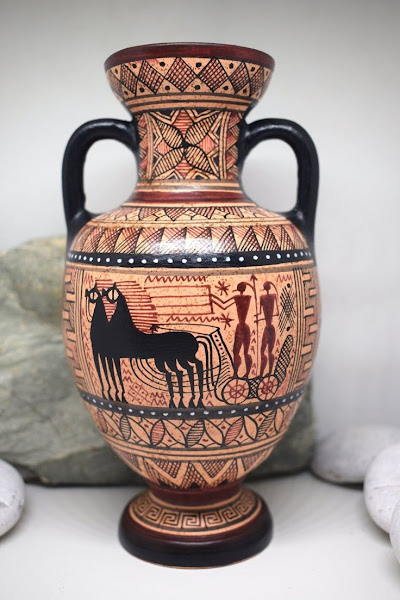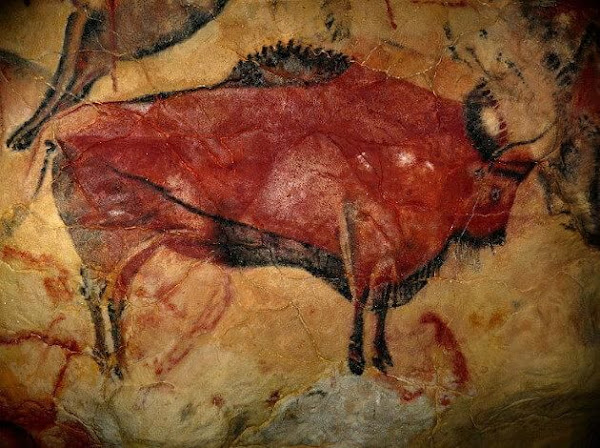Preamble
This is the twelfth post in a new Art Resource series that specifically focuses on techniques used in creating artworks. For your convenience I have listed all the posts in this new series below:
Drawing Art
Painting Art - Part I
Painting Art - Part II
Painting Art - Part III
Painting Art - Part IV
Painting Art - Part V
Painting Art - Part VI
Home-Made Painting Art Materials
Quality in Ready-Made Artists' Supplies - Part I
Quality in Ready-Made Artists' Supplies - Part II
Quality in Ready-Made Artists' Supplies - Part III
Historical Notes on Art - Part I
Historical Notes on Art - Part II
Historical Notes on Art - Part III
Historical Notes on Art - Part IV
Historical Notes on Art - Part V
Tempera Painting
Oil Painting - Part I
Oil Painting - Part II
Oil Painting - Part III
Oil Painting - Part IV
Oil Painting - Part V
Oil Painting - Part VI
Pigments
Classification of Pigments - Part I
Classification of Pigments - Part II
Classification of Pigments - Part III
Pigments for Oil Painting
Pigments for Water Color
Pigments for Tempera Painting
Pigments for Pastel
Japanese Pigments
Pigments for Fresco Painting - Part I
Pigments for Fresco Painting - Part II
Selected Fresco Palette for Permanent Frescoes
Properties of Pigments in Common Use
Blue Pigments - Part I
Blue Pigments - Part II
Blue Pigments - Part III
Green Pigments - Part I
Green Pigments - Part II
Red Pigments - Part I
Red Pigments - Part II
Yellow Pigments - Part I
Yellow Pigments - Part II
Brown and Violet Pigments
Black Pigments
White Pigments - Part I
White Pigments - Part II
White Pigments - Part III
Inert Pigments
There have been one hundred and thirteen posts in a previous Art Resource series that focused on the following topics:
(i) Units used in dyeing and printing of fabrics.
(ii) Occupational, health & safety issues in an art studio.
(iii) Color theories and color schemes.
(iv) Optical properties of fiber materials.
(v) General properties of fiber polymers and fibers - Part I to Part V.
(vi) Protein fibers.
(vii) Natural and man-made cellulosic fibers.
(viii) Fiber blends and melt spun fibers.
(ix) Fabric construction.
(x) Techniques and woven fibers.
(xi) Basic and figured weaves.
(xii) Pile, woven and knot pile fabrics.
(xiii) Napped fabrics, double cloth and multicomponent fabrics.
(xiv) Fabric finishes.
(xv) Schrinkage, durable press and wash-wear finishes.
(xvi) Classification of dyes and dye blends.
(xvii) The general theory of printing.
To access any of the above resources click on the following link - Units Used in Dyeing and Printing of Fabrics. This link highlights the one hundred and thirteenth posts in the previous Art Resource series.
There are eight data bases on this blogspot, namely: (1) the Glossary of Cultural and Architectural Terms; (2) Timelines of Fabrics, Dyes and Other Stuff; (3) A Fashion Data Base; (4) the Glossary of Colors, Dyes, Inks, Pigments and Resins; (5) the Glossary of Fabrics, Fibers, Finishes, Garments and Yarns; (6) Glossary of Art, Artists, Art Motifs and Art Movements; (7) Glossary of Paper, Photography, Printing, Prints and Publication Terms; (8) Glossary of Scientific Terms.
Note: From time-to-time all the above data bases will be updated.
If you find any post on this blog site useful, you can save it or copy and paste it into your own "Word" document for your future reference. For example, Safari allows you to save a post (e.g., click on "File", click on "Print" and release, click on "PDF" and then click on "Save As" and release - and a PDF should appear where you have stored it). Safari also allows you to mail a post to a friend (e.g., click on "File", and then point cursor to "Mail Contents On This Page" and release). Either way, this or any of the other posts on this site may be a useful Art Resource for you.
The new Art Resource series will be the first post in each calendar month. Remember, these Art Resource posts span information that will be useful for a home hobbyist to that required by a final year University Fine-Art student. Undoubtedly, some parts of any Art Resource post may appear far too technical for your needs (skip those mind boggling parts) and whilst other parts may be too simplistic with respect to your level of knowledge (ditto the skip). Hopefully, the trade-off between these two extremes will mean that the Art Resource posts will be useful in parts to most, but unfortunately, may not be satisfying to all!
Historical Notes on Art - Part I [1]
The earliest works of art of which we have definite knowledge are prehistoric, that is they were produced during periods antedating the times for which we possess contemporary records and of which our knowledge is definite or accurate.
Oldest Australian Artwork: Traditional owner Ian Waina inspecting another Naturalistic painting of a kangaroo that we determined to be more than 12,700 years old, based on the age of overlying mud wasp nests. The inset is an illustration of the painting above it.
Picture: Peter Veth and the Balanggarra Aboriginal Corporation.
The word prehistoric is usedf here in a narrow sense, relating directly to art, and does not necessarily imply that we have no definite, accurate knowledge of other aspects of cultures that produced these works of art.
In Chauvet France, the red ochre handprints and stencils are found in chambers throughout the ancient cave.
With some countries - for example, ancient Greece - we have a good knowledge of the civilization, the literature, architecture, ceramics, etc., but only a vague idea of materials and methods used in mural and easel painting.
Ancient Greek Ceramic Amphora Vase of the Geometric Period.
Ancient Greek warrior, Mural painting, Archeological.
Our information concerning the methods and materials of these periods is derived from relics, archaeological discoveries, and the writings of the earliest historians. Considerable time separated these writers from the periods in question, and although much of the value has been learned from them, their writings also contain much that is legendary, vague, and inaccurate; some processes are described correctly in accordance with methods which have survived or developed along similar lines down to the present day, while other statements are of the weirdest sorts of fantasy. Sometimes, important archeological discoveries such as Troy and Knossos have substantiated historical or epic legends which have been previously considered unfounded on actual fact.
The most valuable aid in reconstructing an old painting method and arriving at a definite conclusion is an intimate knowledge of behaviors and properties of painting materials and the results which may be obtained by various manipulations, gained through first-hand painting experience and experiment.
Fall of Troy - Giorgio Ghisi - Hermitage Museum.
All the raw materials used in art techniques, with the exception of some few new products or improved grades introduced during the recent age of industrial and scientific development, are of far greater antiquity than is popularly supposed. The materials which were considered as improvements during the introduction of various techniques from the thirteenth century on, were well known to the ancients.
This is thought to be the oldest painting in the world as distinct from mark-making and/or printmaking on cave walls.
The principal literary sources which mention painting materials and methods of the classical period and upon which investigators have based many deductions are Vitruvius and Pliny, with lesser accounts by Theophrastus and Diocorides.
Portrait Of Vitruvius, Roman architect who lived in the 1st Century BC is a drawing by unknown artists.
Interesting examples of the different sorts of records that have come down to us may be found in Pliny's "Natural History". In one instance, he describes the manufacture of white lead in just the same way as it is made by the "old Dutch process" today, some 1900 years later. Then in the same vein he relates the source of dragon's blood (a vegetabe product from the fruit of an Asiatic tree) which he tells us is not the simple blood of dragons, but is produced when dragons and elephants meet in mutual mortal combat, the dragon crushing the elephant in its coils and in turn being crushed by the weight of the dying elephant. The product, he says, is a thicker matter which issues from the dragon, mixed with the commingled blood of both beasts. He states that it is the only color that in painting gives proper representation of blood; elsewhere he remarks on how men of former days, the Greeks with their simple mineral palettes, produced work superior to those of his own day even when they now had resources as "the slime of India's river [indigo] and the blood of her dragons and elephants."
Reference:
[1] The Artist's Handbook of Materials and Techniques, R. Mayer, (ed. E. Smith) 4th Edition, Faber and Faber, London (1981).
This is the twelfth post in a new Art Resource series that specifically focuses on techniques used in creating artworks. For your convenience I have listed all the posts in this new series below:
Drawing Art
Painting Art - Part I
Painting Art - Part II
Painting Art - Part III
Painting Art - Part IV
Painting Art - Part V
Painting Art - Part VI
Home-Made Painting Art Materials
Quality in Ready-Made Artists' Supplies - Part I
Quality in Ready-Made Artists' Supplies - Part II
Quality in Ready-Made Artists' Supplies - Part III
Historical Notes on Art - Part I
Historical Notes on Art - Part II
Historical Notes on Art - Part III
Historical Notes on Art - Part IV
Historical Notes on Art - Part V
Tempera Painting
Oil Painting - Part I
Oil Painting - Part II
Oil Painting - Part III
Oil Painting - Part IV
Oil Painting - Part V
Oil Painting - Part VI
Pigments
Classification of Pigments - Part I
Classification of Pigments - Part II
Classification of Pigments - Part III
Pigments for Oil Painting
Pigments for Water Color
Pigments for Tempera Painting
Pigments for Pastel
Japanese Pigments
Pigments for Fresco Painting - Part I
Pigments for Fresco Painting - Part II
Selected Fresco Palette for Permanent Frescoes
Properties of Pigments in Common Use
Blue Pigments - Part I
Blue Pigments - Part II
Blue Pigments - Part III
Green Pigments - Part I
Green Pigments - Part II
Red Pigments - Part I
Red Pigments - Part II
Yellow Pigments - Part I
Yellow Pigments - Part II
Brown and Violet Pigments
Black Pigments
White Pigments - Part I
White Pigments - Part II
White Pigments - Part III
Inert Pigments
There have been one hundred and thirteen posts in a previous Art Resource series that focused on the following topics:
(i) Units used in dyeing and printing of fabrics.
(ii) Occupational, health & safety issues in an art studio.
(iii) Color theories and color schemes.
(iv) Optical properties of fiber materials.
(v) General properties of fiber polymers and fibers - Part I to Part V.
(vi) Protein fibers.
(vii) Natural and man-made cellulosic fibers.
(viii) Fiber blends and melt spun fibers.
(ix) Fabric construction.
(x) Techniques and woven fibers.
(xi) Basic and figured weaves.
(xii) Pile, woven and knot pile fabrics.
(xiii) Napped fabrics, double cloth and multicomponent fabrics.
(xiv) Fabric finishes.
(xv) Schrinkage, durable press and wash-wear finishes.
(xvi) Classification of dyes and dye blends.
(xvii) The general theory of printing.
To access any of the above resources click on the following link - Units Used in Dyeing and Printing of Fabrics. This link highlights the one hundred and thirteenth posts in the previous Art Resource series.
There are eight data bases on this blogspot, namely: (1) the Glossary of Cultural and Architectural Terms; (2) Timelines of Fabrics, Dyes and Other Stuff; (3) A Fashion Data Base; (4) the Glossary of Colors, Dyes, Inks, Pigments and Resins; (5) the Glossary of Fabrics, Fibers, Finishes, Garments and Yarns; (6) Glossary of Art, Artists, Art Motifs and Art Movements; (7) Glossary of Paper, Photography, Printing, Prints and Publication Terms; (8) Glossary of Scientific Terms.
Note: From time-to-time all the above data bases will be updated.
If you find any post on this blog site useful, you can save it or copy and paste it into your own "Word" document for your future reference. For example, Safari allows you to save a post (e.g., click on "File", click on "Print" and release, click on "PDF" and then click on "Save As" and release - and a PDF should appear where you have stored it). Safari also allows you to mail a post to a friend (e.g., click on "File", and then point cursor to "Mail Contents On This Page" and release). Either way, this or any of the other posts on this site may be a useful Art Resource for you.
The new Art Resource series will be the first post in each calendar month. Remember, these Art Resource posts span information that will be useful for a home hobbyist to that required by a final year University Fine-Art student. Undoubtedly, some parts of any Art Resource post may appear far too technical for your needs (skip those mind boggling parts) and whilst other parts may be too simplistic with respect to your level of knowledge (ditto the skip). Hopefully, the trade-off between these two extremes will mean that the Art Resource posts will be useful in parts to most, but unfortunately, may not be satisfying to all!
Historical Notes on Art - Part I [1]
The earliest works of art of which we have definite knowledge are prehistoric, that is they were produced during periods antedating the times for which we possess contemporary records and of which our knowledge is definite or accurate.
Oldest Australian Artwork: Traditional owner Ian Waina inspecting another Naturalistic painting of a kangaroo that we determined to be more than 12,700 years old, based on the age of overlying mud wasp nests. The inset is an illustration of the painting above it.
Picture: Peter Veth and the Balanggarra Aboriginal Corporation.
The word prehistoric is usedf here in a narrow sense, relating directly to art, and does not necessarily imply that we have no definite, accurate knowledge of other aspects of cultures that produced these works of art.
In Chauvet France, the red ochre handprints and stencils are found in chambers throughout the ancient cave.
With some countries - for example, ancient Greece - we have a good knowledge of the civilization, the literature, architecture, ceramics, etc., but only a vague idea of materials and methods used in mural and easel painting.
Ancient Greek Ceramic Amphora Vase of the Geometric Period.
Ancient Greek warrior, Mural painting, Archeological.
Our information concerning the methods and materials of these periods is derived from relics, archaeological discoveries, and the writings of the earliest historians. Considerable time separated these writers from the periods in question, and although much of the value has been learned from them, their writings also contain much that is legendary, vague, and inaccurate; some processes are described correctly in accordance with methods which have survived or developed along similar lines down to the present day, while other statements are of the weirdest sorts of fantasy. Sometimes, important archeological discoveries such as Troy and Knossos have substantiated historical or epic legends which have been previously considered unfounded on actual fact.
The most valuable aid in reconstructing an old painting method and arriving at a definite conclusion is an intimate knowledge of behaviors and properties of painting materials and the results which may be obtained by various manipulations, gained through first-hand painting experience and experiment.
Fall of Troy - Giorgio Ghisi - Hermitage Museum.
All the raw materials used in art techniques, with the exception of some few new products or improved grades introduced during the recent age of industrial and scientific development, are of far greater antiquity than is popularly supposed. The materials which were considered as improvements during the introduction of various techniques from the thirteenth century on, were well known to the ancients.
This is thought to be the oldest painting in the world as distinct from mark-making and/or printmaking on cave walls.
The principal literary sources which mention painting materials and methods of the classical period and upon which investigators have based many deductions are Vitruvius and Pliny, with lesser accounts by Theophrastus and Diocorides.
Portrait Of Vitruvius, Roman architect who lived in the 1st Century BC is a drawing by unknown artists.
Interesting examples of the different sorts of records that have come down to us may be found in Pliny's "Natural History". In one instance, he describes the manufacture of white lead in just the same way as it is made by the "old Dutch process" today, some 1900 years later. Then in the same vein he relates the source of dragon's blood (a vegetabe product from the fruit of an Asiatic tree) which he tells us is not the simple blood of dragons, but is produced when dragons and elephants meet in mutual mortal combat, the dragon crushing the elephant in its coils and in turn being crushed by the weight of the dying elephant. The product, he says, is a thicker matter which issues from the dragon, mixed with the commingled blood of both beasts. He states that it is the only color that in painting gives proper representation of blood; elsewhere he remarks on how men of former days, the Greeks with their simple mineral palettes, produced work superior to those of his own day even when they now had resources as "the slime of India's river [indigo] and the blood of her dragons and elephants."
Reference:
[1] The Artist's Handbook of Materials and Techniques, R. Mayer, (ed. E. Smith) 4th Edition, Faber and Faber, London (1981).










No comments:
Post a Comment